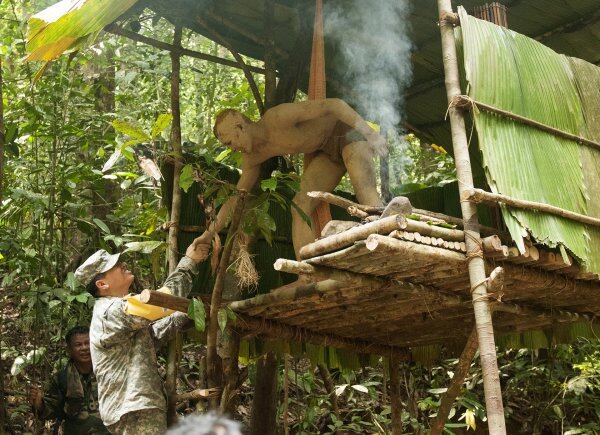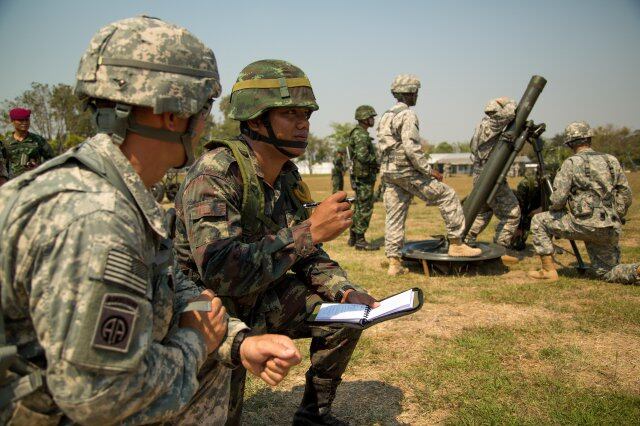The Army is set to expand its Pacific Pathways missions in a number of ways that could include more exotic locations and new roles for National Guardsmen and Reservists.
And new this summer — leaders are also throwing the exercise into reverse. Instead of sending soldiers to Singapore, Japan and Canada, troops from those countries will train with U.S. forces in Hawaii, Washington State and Alaska.
This will be the first time the Army will conduct a so-called reverse Pathway. The operation, scheduled for July through September, is just the next iteration of the growing Pacific Pathways program, which made its debut in 2014.
"This is an opportunity to get [our partners] to train in our training areas and give them an opportunity to deploy," said Lt. Gen. Stephen Lanza, commanding general of I Corps and Joint Base Lewis-McChord, Washington. "It's something we collectively discussed with the different countries, and we came up with an innovative way to do this."
Also this summer, soldiers from 2nd Stryker Brigade Combat Team, 2nd Infantry Division will head out into the Asia-Pacific region to train with the Thai, Malaysian and Indonesian armies. The 25th Infantry Division headquarters will stand up a tactical command post on Fort Magsaysay in the Philippines, where they'll run mission command for the duration of the Pathway.

U.S. and Malaysian soldiers make their way down a steep incline during a foot patrol in the jungle during Exercise Keris Strike in Malaysia.
Photo Credit: Army
Work is already underway to plan for Pathways in 2017, although it's too early to say what those might look like or how many there will be, Lanza said. The Army is looking to grow Army Reserve and Army National Guard involvement as well as incorporate its fires brigades, military intelligence units and other enablers in future exercises.
"Pathways will continue to evolve," Lanza said.
Also in the works are potential new partnerships with countries such as Brunei, India, Bangladesh and Cambodia, he said.
The Pathways concept employs a single unit through what officials call a "training pathway." This unit spends three to four months in a series of already approved, consecutive bilateral and multilateral exercises and engagements with foreign militaries.
Pathways are part of the Army's contribution to the United States' rebalance to the Asia-pacific region. They also line up with the Army's regionally aligned forces concept, which aims to commit troops to a specific region of the world to support the geographic combatant commanders.
The Army ran three Pathways in fiscal year 2015, with stops in Mongolia, Japan, South Korea, Thailand, the Philippines, Malaysia, Australia and Indonesia.
It is running three Pathways again this year, including the first-ever reverse Pathway.
"We've continued to evolve and grow how we build readiness on these Pathways, and looking for different ways to improve how we conduct them," Lanza said.
Pathways is more than just theater security cooperation and building partner capacity, he said.
"It's really about enhanced interoperability. It's really about enhanced readiness," Lanza said.
It's also a way to continue growing relationships with partner nations, he said, as "other countries are saying 'how can I be a part of this operation?'"

Col. Jonathan Wung, the then-commander of U.S. Army Pacific Support Unit, shakes hands with a Malaysian Armed Forces service member who is demonstrating survival techniques as part of the Keris Strike exercise in Malaysia.
Photo Credit: Spc. Lisa Laughlin/Army
Pacific Pathways gives soldiers a chance to practice deploying and train in different environments, Lanza said.
"Any time you have a chance to train in a different operating environment, it enhances the readiness of our formations," he said. "We get multiple repetitions of deployments. We get multiple repetitions of how to do mission command in austere locations. We get multiple repetitions of doing live-fire training in different countries. We train on interoperability with our partners that we don't necessarily get a chance to do here. These are all things you just don't get at home station."
The three- to four-month tours also are a boost for soldiers, Lanza said.
"Every soldier wants to deploy," he said. "Soldiers join the Army to deploy and to go do this. When these soldiers go on these Pathways, they get to do their wartime mission but they get to do it in a different country, whether it's training in the jungles of Indonesia or Malaysia, or a live-fire exercise in the Philippines."

U.S. and Royal Thai Army soldiers conduct familiarization training in Thailand prior to the start of Cobra Gold 2015.
Photo Credit: Spc. Steven Hitchcock/Army
The next Pathways will kick off in June, with soldiers from 2nd Stryker Brigade Combat Team, 2nd Infantry Division. The unit is fresh off a rotation at the National Training Center at Fort Irwin, California.
The soldiers will travel first to Thailand for Hanuman Guardian. Their next stop will be Indonesia for Garuda Shield, and they'll wrap up in Malaysia with Keris Strike.
The addition of a tactical command post forward-stationed in the Philippines for the duration of the Pathway is new.
"We have a tremendous relationship with the Philippines, and this is a tremendous opportunity to partner with the Filipinos there with our land forces," Lanza said.
The reverse Pathway will kick off in July, which means it will overlap with the second half of the Pathways in Thailand, Indonesia and Malaysia.
"We'll have three countries coming to our locations, using three training areas simultaneously," Lanza said.
About a battalion's worth of Singaporean soldiers will train in Hawaii's Pohakuloa Training Area for Tiger Balm in July. The Singaporeans will train with soldiers from 3rd Brigade Combat Team, 25th Infantry Division.
The Canadians will send a battalion task force to Alaska's Joint Base Elmendorf-Richardson for Arctic Anvil with soldiers from 1st Stryker Brigade Combat Team, 25th Infantry Division.
And about 700 Japanese soldiers will train at Yakima Training Area in Washington for Rising Thunder with soldiers from 2nd Stryker Brigade, 2nd Infantry Division.
"This is a unique opportunity for us, and it's a unique opportunity for them," Lanza said.
All of this activity contributes to increased readiness for I Corps and the Army, Lanza said.
"It gets after our readiness, to making sure we're flexible and ready to do anything globally as required," he said.
It also keeps his soldiers busy, Lanza said.
"Everybody's busy. The Army's busy," he said. "And as we're looking at force structure and as we're looking to the future, our requirements continue to grow, and our partners continue to want to do more with us."
Michelle Tan is the editor of Army Times and Air Force Times. She has covered the military for Military Times since 2005, and has embedded with U.S. troops in Iraq, Afghanistan, Kuwait, Haiti, Gabon and the Horn of Africa.





